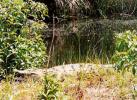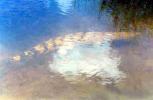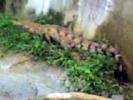| |
|
|
| |
|
VISITS |
|
755988 |
|
Copyright 2013
waypoints.ph |
|
|
Click on any of the images to see the enlarged copy and narratives of the photo.



Just 21 kilometers from San Mariano Town Proper lies the Temporary Holding Pen of the Philippine Crocodile here in San Mariano Isabela.
The story began in 1999 when this crocodile was accidentally caught by a fisherman in Bgy. Cataguing San Mariano Isabela. It was turned-over to the Field Staff of Plan Philippines-Northern Sierra Madre Natural Park Conservation Project operated in the Buffer zone of the park and holding its office in San Jose San Mariano Isabela. About a year and a half this crocodile was temporarily taken care of by the staff before the construction of the temporary holding pen here in San Jose San Mariano Isabela.
This Philippine Crocodile also locally named as bukarot (Crocodylus mindorensis) is considered the most critically endangered species in the world today as listed in the International Union in the Conservation of Nature(IUCN). Hunting, destructive logging, illegal fishing and human interventions in the forestlands leads to the decreased or even vanished the population of the crocodile in the Philippines. Rural poverty is the most leading factor in the destruction of the natural habitat of the freshwater crocodile.In the Province of Isabela particularly in San Mariano lies the remaining population of freshwater crocodile actively and religiously protected by the people and the local government of San Mariano. Legislative measures was undertaken by the local government unit to strengthen the protection of bukarot in the area. The bukarot was declared as flagship species of San Mariano and crocodile sanctuary was established in Sitio San Isidro, Disulap, San Mariano, Isabela. Creation of Bantay Sanctuaryo commenced. The Protected Area Management Board(PAMB) of NSMNP, a multi-sectoral organization declared the area sitio San Isidro to Sitio Dunoy as the Crocodile Management Zone.
Conservation measures are also undertaken in the watershed of the established crocodile sanctuary. Reforestation and agro-forestry farms was established to rehabilitate the degraded areas to ensure the survival of the remaining population on freshwater crocodile. The Reforestation Project named NARRA or the Native Advocacy for Rural Reconstruction and Agro-Forestry was established in implemented in 2004. This project is managed by San Isidro Agro-Forestry Developers MPCI in Partnership with LGU San Mariano. The goal of this project is to create an innovative mechanism for sustainable development in the Crocodile Management Zone in the Northern Sierra Madre Natural Park (NSMNP).
August 27, 2006. In preparation for the historic event. The Team was set to capture margie in the holding pen. There, the team checks the health status of margie. Important statistical data was taken to monitor it's growth and development. A veterinarian from provincial agriculture office was joined the team. A transmitter was also attached to the anterior back for monitoring purposes and further study of it's characteristics and behavior in the wild . The Team was all set to transport margie from holding pen to the release area in San Isidro Creek inside the NARRA Project. Using the weapons carrier (4 wheel drive vehicle) we travel 34 kilometers away from the holding pen. Strong and healthy margie will be released on August 28, 2006.
As a former member of Plan Staff in 1999, i joined the CROC (Crocodile Rehabilitation, Observation and Conservation) team to released Margie a.k.a Isabela (name of the bukarot) in the wild on August 28, 2006. The Local Government of San Mariano, Mabuwaya Foundation Inc., Isabela State University - Cabagan Isabela, Cagayan Valley Programme for Environment and Development (CVPED)-Cabagan, Media Men from Local Radio and TV Station, Print Media and DENR RO2 led the expedition team to release margie in the wild. The first freshwater crocodile released in the wild ever recorded in the history of wildlife conservation in the Philippines.
How to get there:
Thirty three (33) kilometer from San Mariano Town Proper to the released area by for hired 4WD vehicles available in SMTP at 3,500.00php per day. This location is more than a kilometer away from the Crocodile Sanctuary. During sundays, there available passenger vehicles going to San Isidro for only at 50.00php per person. This type of vehicles is the only mode of transport in the area because in can travel in dirt roads (old logging roads) and has the powerful ability to cross rivers and creeks without hassle.
Local and international tourist, students from all over the province have visited the crocodile holding pen and the crocodile sanctuary. Although the scenery along the way has not much to offer, but seeing the crocodile basking in wild or swimming on the lake is once in a lifetime experience. And of course, this locations are overlooking the Sierra Madre Mountain Range.
Note: You can visit the temporary holding area of juvinile crocodiles in Councilor Jerome Stanley Miranda's residence in Minanga San Mariano Isabela. There you can see juveniles with age ranges from less than to more than a year old hatchlings. This temporary holding area was established to ensure the high rate of survival of the juviniles and managed by the SB Miranda a.k.a "father of the crocdiles". Just like margie they will soon be released in the crocodile sanctuary.
Contact Agencies/Persons:
Local Government Unit/Councilor Jerome Stanley Miranda, San Mariano, Isabela
Mabuya Foundation, Inc./Dr. Andres Masipique?a, President
Cagayan Valley Programme on Environment and Developmentand/Jan Van der Ploeg CVPED Coordinator,
ISU Cabagan Isabela
Lito Pregilliana/Chairman SIAFDMPCI,
Sitio San Isidro, Disulap, San Mariano, Isabela
Marcos Pascua/Barangay Captain Disulap, San Mariano, Isabela
Marites Gatan-Balbas, Community Organizer CROC Project.Waypoint narrative by: spiderman 2006
Additional narratives or blogs:
Philippine Crocodile is considered to be the most critically endangered reptilian species in the world. Hunting and killing are the reasons why the number of this species declined. In region 2, this species is considered to be extinct, until a fisherman (Mr. Samuel Francisco) accidentally caught it in Dimalicon-licon Creek, Sitio San Isidro, Disulap San Mariano, Isabela in March 17, 1999. Mr. Francisco informed the San Mariano Field Staff of the Northern Sierra Madre Natural Park Conservation Project. Immediately, the San Mariano Field Staff proceeded to San Isidro and informed Mr. Francisco of the status of the said species. Without hesitation, Mr. Francisco turned-over the species to the team. The crocodile, now named Isabela, was placed and taken care of by the NSMNPCP San Mariano Field Staff for two years in the San Mariano Field Office. Since then, the NSMNPCP field staff is very vigilant when they hear news that a crocodile was sold to a certain person. Extensive information, education and communication campaigns were also conducted to protect and conserve the said species. As a result, three other crocodiles were turned-over to the team. The NSMNPCP in this juncture, decided to construct the Municipal Crocodile Rescue Center in San Jose, San Mariano, Isabela where Mr. Fernando Domingo (a deputized Bantay Sanktwaryo member) took care of the crocodiles.
Since then the Fauna Team of the NSMNP-CP conducted research focused on the population and searching for crocodile habitats in the Municipality of San Mariano.
With the need for the conservation of the Philippine Crocodile, the San Mariano Team lobbied intensively for legislative support from the Sangguniang Bayan of San Mariano. The Local Government Unit of San Mariano immediately responded by enacting two ordinances: 1) that of prohibiting the hunting and killing of crocodiles and, 2) declaring the Philippine Crocodile (Crocodylus mindorensis) as the flagship species of the municipality. With the GIS data gathered and the proposed regulations prepared by the Fauna Team of NSMNPCP, another ordinance was passed by the Sangguniang Bayan � that of declaring a 10-kilometer stretch of the Diwagden river as the Philippine Crocodile Sanctuary. Later on, the LGU San Mariano deputized twelve Bantay Sanktwaryo members to help in the protection and monitoring of crocodile populations in the municipality.
The local communities are now protecting the Philippine crocodile in the wild and its habitat. Two crocodile sanctuaries were already declared in the municipality.
In 2001, the First Philippine Crocodile Conservation Workshop was held in Isabela. This was attended by different stakeholders in the world. The milestone of this workshop was the formulation of the Philippine Crocodile Conservation Action Plan. However, in 2002, the NSMNPCP phased-out. This time the Mabuwaya Foundation Inc. who is implementing the Crocodile Rehabilitation, Observance and Conservation (CROC) Project took over the conservation and protection of the Philippine crocodile in the wild. The CROC team is composed of Filipinos and Dutch who are concerned in the protection and conservation of crocodiles in their natural habitats. The CROC Team is continuously implementing the activities stated in the crocodile conservation action plan. They conduct researches on Philippine crocodile behaviors, ecology and telemetry. They continue the Communication, Education and Public Awareness (CEPA) Campaigns to local communities especially those living near the crocodile habitat. The CROC team also gives training to Bantay Sanktwaryo members and local officials.
The CROC team, in its desire to protect the crocodile in its natural habitat, released back just last August 28, 2007 the first captured crocodile in San Mariano. The crocodile was named Isabela, after the name of the province. Isabela was released in Dunoy Lake by the Chairman, Committee on Environment and Natural Resources of the Municipal Council, Jerome Stanley Q. Miranda and the former Executive Director of the Northern Sierra Madre Natural Park Conservation Project, Dr. Roberto R. Ara�o. They are assisted by the members of the CROC team. Isabela was one of the third batch of Philippine crocodiles ever released back in the wild by the CROC Team members.
How to get there:
Sitio Dunoy is small village found in the foothills of the Northern Sierra Madre Natural Park. It is located 33 kilometers away from the San Mariano Town Proper. One can reach the place by riding in a 6x6 truck (logging truck) for 1.5 hours at Php. 50.00 or hiring trucks atPhp. 3,500.00/day. While in the village, one can enjoy swimming in the crystal clear water of the Catallangan River, overlooking the Sierra Madre Mountains. Early in the morning, while sitting in the watch tower, one can enjoy seeing the beauty of the crocodiles basking in the logs at Dunoy Lake. And at night time, one can enjoy counting the crocodiles by the red glow of their eyes as it reflects light.
Location of the release site: Dunoy Lake. Dibuluan, San Mariano, Isabela 16deg 59min 56.5sec N 122deg 09min 14.0sec E
By: spiderman 2007
|
|
|